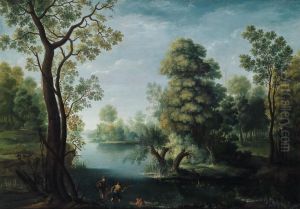Jean-Evangeliste Dorfmeister Paintings
Jean-Evangeliste Dorfmeister, also known as Johann Evangelist Dorfmeister, was an Austrian painter born in 1740 in Strassengel, Styria. While not as widely recognized as some of his contemporaries, Dorfmeister contributed significantly to the art of the late Baroque and early Neoclassical periods. His work mainly consisted of religious themes, characterized by their detailed execution and adherence to the stylistic elements of the time.
Dorfmeister received his initial training from local artists before moving to Vienna, where he continued his studies. Vienna, during the mid to late 18th century, was a bustling center of art and culture, influenced by the reign of the Habsburgs and the broader European Enlightenment. In this environment, Dorfmeister was exposed to a range of artistic styles and techniques, which he absorbed and integrated into his work.
Throughout his career, Dorfmeister worked on various commissions, most notably for churches and religious institutions. His frescoes and altarpieces can be found in different parts of Austria. One of his most significant contributions is the frescoes in the Tieschen church in Styria, which showcase his skill in creating elaborate compositions with a clear narrative quality.
Dorfmeister's works are typical of the late Baroque period, with their dramatic use of light and shadow, sense of movement, and emotional expressiveness. As the art world began to shift towards Neoclassicism, Dorfmeister's style also evolved, showing a greater emphasis on line and form, and a more restrained approach to color and ornamentation.
Despite his talent and contributions to the art world, Dorfmeister did not achieve the same level of fame as some of his peers. Nevertheless, his paintings and frescoes remain important examples of the artistic transitions occurring in the late 18th and early 19th centuries. Jean-Evangeliste Dorfmeister died in 1812. His works continue to be studied by art historians and can be appreciated in various churches and museums, primarily in Austria.
